Rotisserie chicken has earned its place as one of America’s favorite dinners and meal prep hacks. It’s a beloved staple that shows up everywhere: at potlucks and tailgate parties, stuffed into lunch wraps, tossed into salads, or eaten cold straight out of the fridge as a late-night snack. It’s reliably affordable, lasts in the fridge for days, and can be used in many protein-packed recipes.
As for its popularity, the numbers speak for themselves. In 2023, Costco executives told its shareholders that it had sold 137 million rotisserie chickens (via the Seattle Times). Sales across the rotisserie chicken market show no signs of slowing, according to data from Verified Market Reports. In addition to Costco, stores like Sam’s Club, Walmart, and regional chains carry rotisserie chickens made fresh daily, even with different seasoning blends: Ingles offers lemon pepper and Italian herb, while Southern grocer Publix offers varieties like Mojo. The chicken is flavorful enough as it is, but it’s still versatile enough to take on any sauce or seasoning you throw at it. Pair it with the right sauce, and your store-bought rotisserie chicken transforms into something sweet, spicy, tangy, herby, or all of the above.
The next time you need some inspiration, check out this list of the best sauces to pair with rotisserie chicken. Some are classic comforts while others bring global flair. Whichever you choose, these sauces prove that a plain rotisserie chicken can be the start of something much more exciting than a basic dinner.
Read more: 12 Absolute Best BBQ Sauces For Chicken
Classic gravy
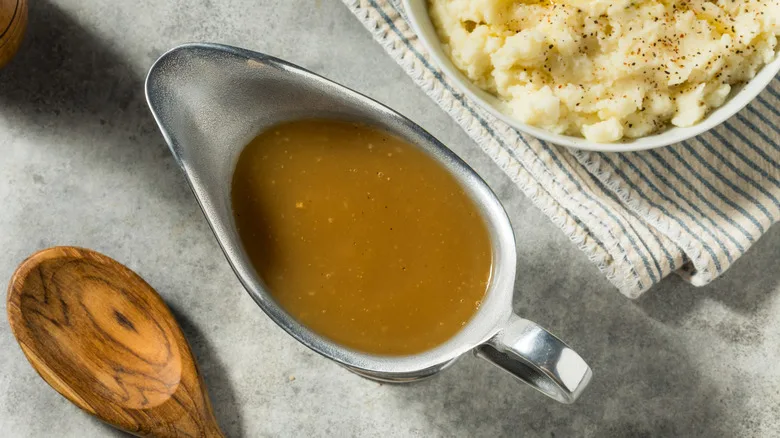
Rich brown gravy in silver serving dish with spoon and mashed potatoes – Bhofack2/Getty Images
Few things are as comforting as roasted chicken smothered in gravy. No matter what type of gravy you use, this silky and savory sauce can transform your store-bought rotisserie chicken into a timeless sit-down meal. Chicken and gravy have stuck around for generations because it just works; the flavorful meat and rich sauce deserve each other.
One of the best things about gravy is that there are many ways to make it. If you’re reheating leftover rotisserie chicken, save the drippings to whisk up a pan-style chicken gravy in no time. Or, if convenience is your preference, a store-bought jarred or packet gravy can be just as satisfying, especially if you enhance it with chicken stock, a splash of wine, or fresh herbs.
From traditional brown gravies to creamy white versions, and even copycat takes on fast-food gravy favorites from KFC or Jollibee, there’s no shortage of recipes to try. However you make it, gravy is one of the simplest ways to give rotisserie chicken a comfort food glow-up.
Chimichurri
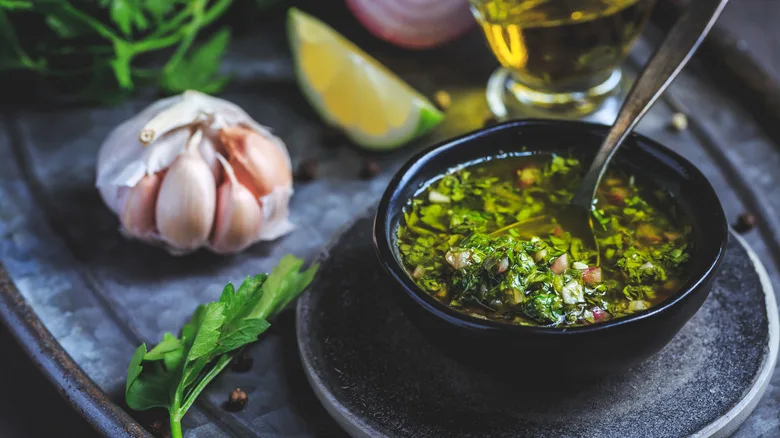
Fresh chimichurri in a small black bowl, surrounded by garlic and herbs – Brebca/Getty Images
This iconic Argentine sauce proves that the right blend of herbs can transform an entire dish. No one can really agree on the origin of its name, but what’s known is that no Argentinian parrilla is ever complete without chimichurri. Often confused for pesto because of its similar green hue, chimichurri’s bright, herby, and vinegary flavor couldn’t be more different. Made from parsley, oregano, garlic, olive oil, and vinegar, it’s traditionally poured over grilled meats, but it’s just as transformative on regular rotisserie chicken.
Chimichurri’s acidity and freshness cut through the richness of the roasted chicken skin, with the garlic adding a good punch without overdoing it. If you don’t have a jar handy, chimichurri is simple to make at home in minutes using fresh herbs and pantry staples.
Once ready, chimichurri is as versatile as the chicken itself. Pour it over warm pieces of chicken, layer into grain bowls, drizzle onto tacos, or spread it onto toasty sandwiches. You can play with the flavor and color by adding tarragon for an herbal lift. Though best known in its green form, a red version also exists, which swaps green herbs for red peppers and smoked paprika. Whichever version you choose, the sauce is a guarantee for bringing herbal brightness and global flair to your rotisserie chicken dinner.
Peri-peri sauce
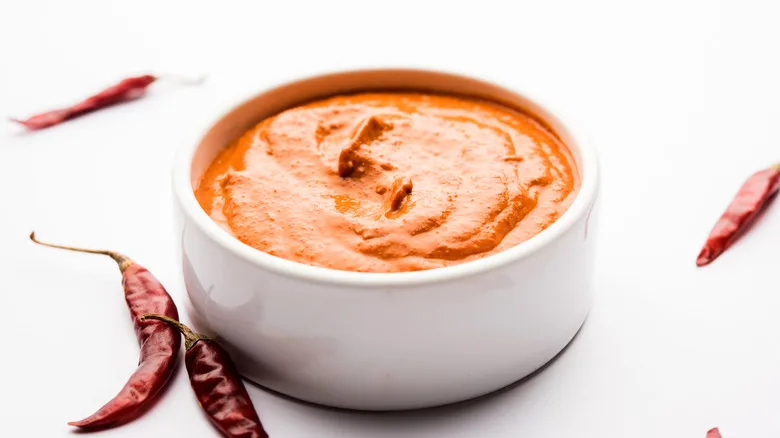
Bowl of peri-peri sauce in a white dish surrounded by hot peppers – Indian Food Images/Shutterstock
Peri-peri sauce, also called piri-piri, is a bold and fiery condiment that adds an undeniable kick to your rotisserie chicken. While most commonly associated with Portuguese cuisine, its roots stretch across the globe from cross-continent exchanges, believed to have had its origins in Africa thanks to Portuguese travelers. The name comes from the Swahili word “pili-pili,” meaning “pepper.”
The pepper in question is the piri-piri chili, also known as the African Bird’s Eye chili. These tiny peppers pack a big punch, measuring from 50,000 to 175,000 Scoville heat units (almost 15 times spicier than a jalapeño). Not all versions of the sauce are blisteringly spicy, though; many recipes balance the spice with ingredients like garlic, paprika, lemon zest, bay leaves, and vinegar.
Beyond the heat, peri-peri is celebrated for its layered flavor profile, thanks to ingredients like garlic, citrus, and herbs. Traditionally, it shines when brushed over flame-grilled chicken, but rotisserie chicken provides an equally delicious canvas. It’s also a perfect way to enhance rotisserie leftovers; basting the chicken with peri-peri sauce before reheating it in the oven or air-fryer will create a smoky, flame-grilled flavor that tastes straight out of a Nando’s kitchen.
While popularized by restaurant chains like Nando’s (you can even purchase bottles of its sauce online), peri-peri is enjoyed across the world. Whether you opt for store-bought or a homemade version, and no matter your spice level preference, peri-peri can turn your simple rotisserie chicken into a fiery and flavorful entree that brings bold flavor to the dinner table.
Alabama white sauce

Rotisserie chicken pieces topped with Alabama white sauce – Brent Hofacker/Shutterstock
Regional barbecue sauces are worth the road trip or making at home. Alabama white sauce might perplex anyone used to standard ketchup- or mustard-based barbecue sauces, but this distinctive sauce has become a Southern icon.
Created in the 1920s by Robert Lee “Big Bob” Gibson in Decatur, Alabama, this sauce was created to keep Big Bob’s chicken tender and moist while imparting a zesty flavor. Most noticeably, it’s set apart from tomato-based sauces by relying on a mayonnaise base for a creamy texture that’s perfect for chicken. Brightened with vinegar and lemon juice and spiced with cayenne and black pepper, you’ll be licking your fingers to catch every last drop of sauce.
While it’s traditionally served with smoked chicken, there’s no reason you can’t drizzle it over your store-bought rotisserie bird, use it for dipping, or top rotisserie chicken sliders with it. The possibilities extend well beyond barbecue, as it makes a flavorful base for an elevated coleslaw in the place of plain mayonnaise. Pick a favorite store-bought bottle to keep handy for convenience, or make a batch from scratch to experience this creamy Southern hallmark. One taste and it’s easy to understand why Alabama white sauce has stood the test of time.
Honey mustard

Cutting board with a bowl of honey Dijon mustard surrounded by garlic, mustard seeds, black peppercorns, and honey – Pixel-Shot/Shutterstock
Sweet, tangy, and endlessly comforting, it’s not surprising that honey mustard has been around for centuries. The honey’s sweetness softens the mustard’s bite. This balance has long been the go-to dip for other comfort foods like chicken tenders and soft pretzels, and it’s what makes it a natural match for rotisserie chicken, too. The condiment has become ubiquitous in fast food and casual dining; countless sauce brands like Sweet Baby Ray’s line grocery store shelves with its bottles, and even Chick-fil-A has started selling bottled versions of the customer-favorite dip.
But one of the beauties of honey mustard is its simplicity, usually consisting of just four ingredients, which opens it up to endless upgrades and variations. Making it at home gives you full control over the flavor balance; all you need is honey, yellow or Dijon mustard, and a creamy binder like mayo or Greek yogurt.
For a version you can easily brush over chicken before reheating under the broiler or even in the air fryer, try making one with Dijon mustard, honey, and olive oil. For a smoky-sweet twist, try this Carolina barbecue-style honey mustard, which adds Worcestershire sauce and cayenne pepper. Whether you make it fresh or reach for your favorite store-bought bottle, honey mustard proves that it can bump your rotisserie chicken from “good” to “irresistible.”
Tzatziki
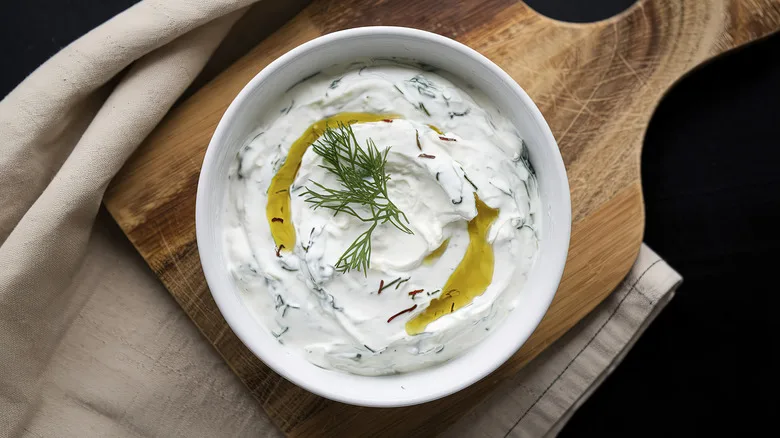
Cutting board with a bowl of fresh tzatziki topped with a drizzle of il and fresh dill – Gabriel Albu / 500px/Getty Images
Tzatziki sauce is a cool and creamy Greek sauce made of yogurt, cucumber, garlic, olive oil, and herbs. It’s long been served with grilled meats, on hearty pitas, or as a side dip for vegetables, and it makes another perfect companion to rotisserie chicken. It works because it offers a brilliant balance of freshness and herbs to the rich flavor of the chicken. The yogurt and cucumber base gives a hydrating body and crunch, and add-ins like garlic, dill, or sometimes mint bring herbal notes, with olive oil rounding it out. It’s indulgent without becoming too heavy.
Buy it from the store, pick up some at your local Greek restaurant, or whip it up at home in minutes. Whether you decide to go heavier on the dill or mint, just make sure that the base you’re using is Greek yogurt, as it differs heavily from regular yogurt and will make or break your homemade tzatziki. Be sure to prepare your cucumbers correctly to avoid a watery dip.
When you spoon tzatziki over your chicken or layer it in a Greek-style wrap with shredded chicken and veggies, this sauce makes every bite of chicken fresh and lively. Whatever you choose, tzatziki brings a cooling contrast to your plain rotisserie. It’s a Mediterranean twist that feels like a full flavor upgrade.
Buffalo sauce
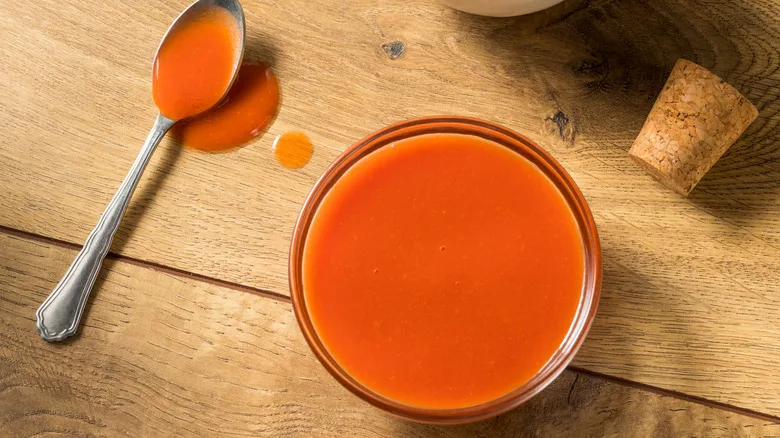
Bowl of Buffalo sauce and spoon against a wooden surface – Bhofack2/Getty Images
Buffalo sauce is one of the most recognizable condiments in American cuisine, with an origin story almost as bold as its flavor. In the 1960s, the city of Buffalo, New York saw multiple cooks experimenting with fried chicken wings tossed in a mix of hot sauce and melted butter. In 1964, the Anchor Bar became known for its version, made by co-owner Teresa Bellissimo, while local restaurateur John Young and earlier cooks also contributed to the dish’s development. Buffalo wings have become a bar food staple and are popular at sports gatherings and American restaurants. Today, Buffalo sauce is more than just coating for wings; it’s a well-known condiment that adds a recognizable kick to wraps, sandwiches, dips, and even salads.
Why does it work so well with chicken? It comes down to balance. The rich butteriness and heat cut through the savoriness of chicken and create layers of flavor balanced with spice in every bite. It transforms your rotisserie chicken into something bold, and it’s perfect for those who like adding a kick to their meals. Whether you lean more towards hot or mild on the spice scale, store-bought Buffalo sauce ranges from mild and tangy to fire-breathing spice. Frank’s RedHot, for one, is a consistent store-bought favorite.
You can even repurpose your rotisserie chicken into a well-loved party dish. Buffalo chicken dip, made with base ingredients of shredded chicken, cream cheese, and Buffalo sauce, is always a hit at potlucks and game-day parties. Whether you drizzle or dip, Buffalo sauce is a dynamic addition to rotisserie chicken dinners, with plenty of opportunity for upgrades and maximum heat level — if you dare.
Peanut sauce
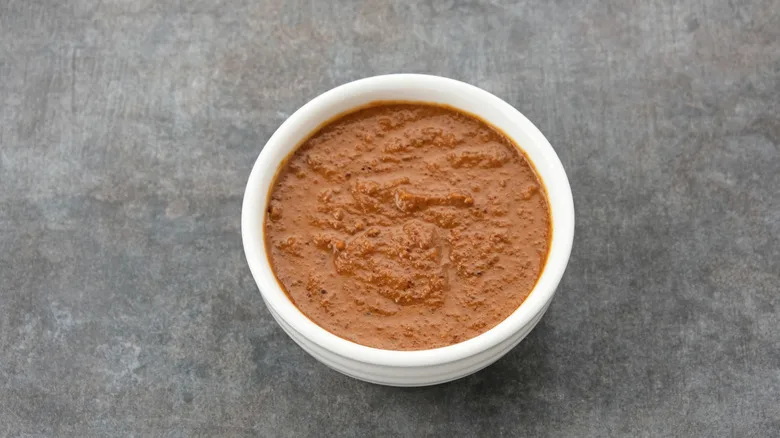
Bowl of spicy peanut sauce – Tyas Indayanti /Getty Images
Peanut sauce is a condiment that feels both comforting and adventurous, thanks to its rich nuttiness, creamy texture, and balance of sweet, salty, tangy, and sometimes spicy flavors. Most famously paired with satay skewers and Southeast Asian dishes, its adaptability makes it just as welcome alongside a simple rotisserie chicken dinner. Protein-packed chicken and silky, nutty sauce create a meal that is as satisfying as it is elevated, and it requires very little effort to make.
The sauce can be simplified to three main ingredients: peanut butter, a savory sauce, and an acid like citrus or vinegar. A satay-style sauce recipe uses ground peanuts for the base as well as peanut butter, with peanut butter, lime juice, soy sauce, powdered garlic, honey, and chili flakes for a hint of spice. Culinary sources document a range of variations, with coconut milk often added for a creamier and less concentrated dip. No matter the recipe, the result is a combined profile of creaminess, sweetness, saltiness, and brightness. You can also add chili sauce to your store-bought peanut sauce for an easy upgrade and just the right amount of heat. For a homemade version, whip up this spicy peanut sauce that uses chili sauce and red pepper flakes to level up the kick.
Rotisserie chicken makes a perfect canvas for peanut sauce because of how the chicken soaks up flavor while keeping its own. Dunk shredded chicken lettuce wraps into the sauce, toss the sauce with chicken and noodles, stir-fry it with some chicken and veggies, or spoon it over chicken and rice bowls.
Teriyaki sauce
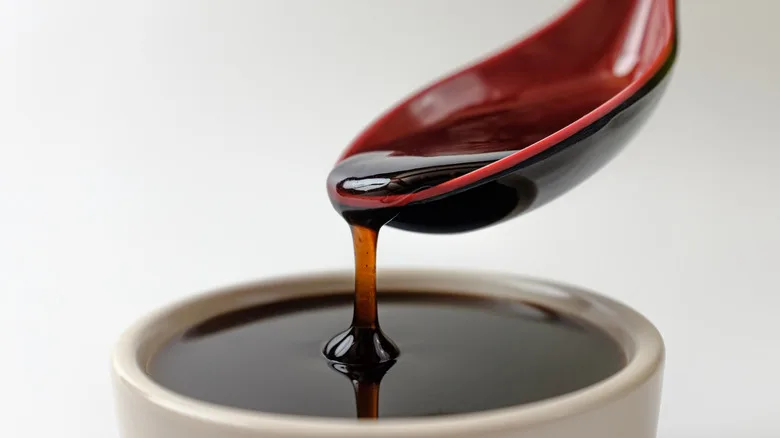
Bowl of teriyaki with a serving spoon dripping sauce into the bowl – Sungmin/Getty Images
Teriyaki has become one of the most familiar “Asian-inspired” flavors on American menus, and its broad appeal alone makes it a natural match for rotisserie chicken. The endlessly versatile sauce manages to be both comforting and crowd-pleasing, with a balance of sweet, savory, and umami flavors that never goes out of style. Popularized by soy sauce brand Kikkoman in American cuisine, teriyaki is a staple on grocery store shelves and home kitchens. Made with soy sauce, sugar, and mirin, the result is a glossy sauce that’s just as good brushed onto grilled skewers and rice bowls as it is drizzled over shredded rotisserie chicken.
Teriyaki does a lot of heavy lifting when paired with chicken. Its sweetness complements the chicken’s caramelized skin, while the soy base makes plain shredded meat taste like it’s been marinated for hours. A store-bought bottle will do the job just fine, and there are plenty of ways to upgrade it at home, or you can try whisking together a quick homemade version so you can adjust the saltiness and sweetness to your liking.
There are plenty of ways to get creative, too. Toss shredded rotisserie chicken with teriyaki, add it to fried rice with leftover chicken and veggies, or use it as a finishing glaze for sandwiches or sliders. However you use it, teriyaki has a way of turning simple rotisserie chicken into a savory, Asian-inspired dish.
Want more food knowledge? Sign up to our free newsletter where we’re helping thousands of foodies, like you, become culinary masters, one email at a time.
Read the original article on Tasting Table.








